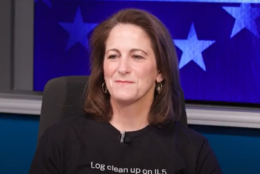Hubbard Radio Washington DC, LLC. All rights reserved. This website is not intended for users located within the European Economic Area.
On Air: Federal News Network
Splunk
-
Migration to the cloud was initially seen as a way to save money. Agencies continue to struggle with shaking off that singular mindset, explains Splunk’s Juliana Vida during Federal News Network’s Cloud Exchange 2022.
September 15, 2022 -
A well-defined hybrid, multi-cloud strategy can help pave the way to digital transformation. During the DoD Cloud Exchange, we talked with Splunk’s Bill Wright about navigating the cybersecurity and management challenges along the route.
March 24, 2022 -
Bill Wright is the senior director of North American Government Affairs at Splunk, joins host John Gilroy on this week's Federal Tech Talk to discuss how his company can help federal technology leaders need to ingest, monitor, analyze and search their agency's data.
December 08, 2021 -
Juliana Vida, the group vice president and chief strategy advisor for public sector at Splunk, said agencies can use the momentum created by the cybersecurity EO, the funding from CISA and the technology advancements of the market to harden their cyber resolve.
December 01, 2021 -
Juliana Vida, the chief technical advisor for public sector at Splunk, said for agencies to successfully and securely move to the cloud they must collect, use and understand their data. She said many times that comes down to using the right security framework.
May 21, 2021 -
Agencies will continue to exist in a multi-cloud world for the foreseeable future.
April 30, 2021 -
Agencies now must sustain the momentum gained from the efforts to meet the surge of remote workers. How they do that is having the ability to monitor and manage these transformations to ensure mission success.
January 29, 2021 -
Data is increasingly the backbone of decision making, which is why the Defense Department is putting so much effort into ensuring a secure, unhindered flow of data between warfighters and leadership with programs like Joint All-Domain Command and Control (JADC2).
January 10, 2021 -
Technology has progressed to the point that the biggest obstacle still preventing JADC2 from becoming a reality is culture. It’s how the services and components interact, how they share – or don’t share – their data.
December 14, 2020 -
While the security benefits of zero-trust architectures are well-known, less recognized is the extra value that zero-trust architectures can create.
August 17, 2020 -
Agencies made the transformation during the pandemic emergency in a short amount of time and now they have to figure out how to continue this momentum.
June 16, 2020 -
The senior advocate for Decennial Census Response Security and Data Integrity at the Census Bureau said the agency has been testing and improving the online response tool and security architecture for much of the past seven years in preparation for 2020.
March 13, 2020 -
There are ways agencies can institutionalize change and take more advantage of data.
January 30, 2020 -
Frank Dimina, vice president of Public Sector at Splunk, joined host John Gilroy on this week's Federal Tech Talk to explain why federal agencies should secure their data sets before applying machine learning and artificial intelligence.
January 24, 2020
















